Abstract
Loess vegetations of the Carpathian Basin have been ploughed for a thousand years. Therefore, loess steppes of verges of the Transdanubia have nearly disappeared. Therefore, in Hungary, it is also important to find out the composition of loess vegetation. The aims of our study were to date the age of the sample verges and explore types of verges. Is there a correlation between the types, location, expanse and vegetation types of the verges? Which of the coenologically important species of the genus Festuca occur in the verges and patches of loess grassland? The studies were carried out in three areas. We examined the age of the verges and their natural condition. Floristic and coenological surveys were applied to analyse the diversity of the verges. Inflorescence morphological analysis of the dominant Festuca species in the vegetation was carried out by analysing 25 parameters. Our results showed that not only the age of verges was valuable and natural. Most of the loess species did not appear in old verges. Consequently, we should not rely only on the age of the verges to make hypotheses about its natural condition and vegetation. Based on the coenological data, there were two types of verges, which were the interspaced verge and the border verge. Based on the diversity assessment from the survey, data of the interspaced verge showed the highest diversity value, the diversity value was higher than 4. Among the studied taxa, Festuca pseudovina was separated clearly as a homogeneous group. The morphotaxonomic parameters were not enough for species identification of F. valesiaca and F. callieri, but they were not enough for F. rupicola neither, so the examination of the sclerenchyma is required. Overall, in contrast to the previous hypothesis, the age of the grassland fragments is not the most important factor, but rather their location, size, the number of species and the diversity are adapted to them.
1. Introduction
Once, there were wide expanses of wooded steppe with grassland in the Carpathian Basin and the Great Hungarian Plain. They were characterized by natural forest-steppe and steppe vegetation [,,,,], which were the westernmost occurrence of the Eurasian vegetation zone [,,,], and also were the western border of Palearctic steppe zone in Europe, with high cover of steppe and steppe-like grasslands in Bulgaria, Hungary, Moldova and Ukraine. Based on the classification of Mucina et al. [], the most important environmental zone of Eastern Europe was the Pannonian–Pontic environmental zone (PAN), which was a significant zone of the Carpathian basin [,,].
The extent of the loess bedrock and its vegetation were significant in the Pannonian area, but nowadays, they have been left in only fragments, mainly because of intensive agricultural activities and expansion of agricultural areas. Therefore, the patches are very important, extending mainly over the central plain of the Pannonian area, but also spreading up to the foothills. Thus, several researchers have investigated these remnant vegetation patches in the central Carpathian Basin [], Szerényi and Kalapos [], Csontos and Tamás [] also discovered remnants of this vegetation in the Transdanubia areas (Balaton-Uplands, Százhalombatta). However, most of the studies were made in the Great Hungarian Plain, where the role of the Cumanian mounds was also significant from among the remnants. These patches of loess remnants are considered as hot spots for vegetation [,,,,,,,,,]. In addition, verges alongside agricultural areas and roads, where the vegetation has been reduced, are also very important as relics of the former vegetation [,]. The significance of these remnants has already drawn attention to the importance of conserving the unplowed land strips, earthen fortifications and earthworks and to the necessity of urgent action by Zólyomi [] in the last century in order to conserve vegetation of grasslands through the conservation, management such as grazing and mowing. Kiss [] found a complex loess grassland at Tatársánc in the southern part of the east of the river Tisza. In spite of the research, these grasslands have disappeared without their values being known, and due to the missing management, invasive species can colonize and spread easily [,,]. As they are often close to agricultural fields, they can be affected by ploughing, leaching of fertilizers and using chemicals. Despite this, several rare species have survived in the remnant areas, such as Salvia nutans and Adonis volgensis [,].
In order to sustain biodiversity, to pay attention to the role of fragmentation of natural and semi-natural habitats is also important worldwide [,,]. Habitat loss reduces the amount of available space that can be occupied by habitat specialist species, while fragmentation decreases the functional connectivity between the remaining habitat patches resulting in a restricted flow of individuals and genes at the metapopulation level []. Habitat loss and fragmentation are often coupled with additional effects such as agricultural activities (e.g., lawn breaking up, use of chemicals, water management) that lead to the degradation of the habitat [,,]. However, the work of Deák et al. [,] reveals that kurgans have still a significant role in the conservation of species, which of traditional management can help to improve [,]. Ecological behaviour and dynamics of species of habitats can also help to sustain the habitats because existence of ecologically variable species can form habitats, and to maintain their functional diversity, but degradation of habitat is possible too [].
Csathó [] categorized verges based on their bordering objects and their origin. We can identify three types of verges: I. interspaced verges, II. border verges and III. periodic verges. Interspaced verges are between two objects (e.g., road-railway, canal-dirt road). Border verges are situated next to roads, railways, canals so on and so forth. Periodic verges are grass verges that are in direct contact with agricultural fields from both sides. He shows the impact on the quality of the grassland that is affected by activities in contact with the verges. He describes that the vegetation of the border verges has usually better condition than the vegetation of the periodic verges, which is damaged by leaching fertilizer. Furthermore, he categorizes the grasslands into two groups based on their origin. According to his opinion, it could be significant for their conservation value. Primary verges preserve traces of original loess vegetation. On the other hand, secondary verges have been left by ploughing (e.g., flood protection embankments). Weeds and generalist species are dominant in these verges [].
Besides the vegetation of the Cumanian mounds, there were several research about ages and structure of their soils [,,,,,,]. Soil and botanical studies help to understand the history of vegetation, too. Knowledge of the current condition and development of vegetation, which is related to soil processes, can provide much help. A detailed botanical survey was carried out on the area of the Csípő mound in the Hortobágy area []. Verges and remnants of loess grassland are also important for their economic utilization, Kiss and Penksza [] and Kiss et al. [,] have investigated this and provided data for changes of vegetation of grazed grasslands [,]. Nagy and Penksza [], Nagy et al. [,] carried out mapping of habitats in parts of the east of the river Tisza and carried out a naturalness assessment of the areas based on the vegetation of the area, which helps to define the origin of the grasslands.
In the study of the vegetation of the verges, grasses are characteristic of the verges, as many of them are dominant, among them the taxonomically non-problematic grasses such as Poa angustifolia, Elymus repens, and Bromus inermis, although one genus was problematic for identification, and that was the genus Festuca, which includes dominant and characteristic species on loess associations. Therefore, taxonomic analysis of the species of this genus was also carried out. During this study, taxa with a transitional sclerenchyma form were also found in the area, which could be observed in species with a bundle sclerenchyma [,]. The Festuca javorkae, which was related to Festuca rupicola, could also be problematic, although this species was clarified [,,] and its species differentiation was shown using molecular studies by Galli et al. [,,]. After clarifying the taxa, our aims were to investigate the multivariate statistical assessment of loess grasslands occurring in different habitats and to reveal the patterns of occurrence of grasslands in the area of the Cumanian mounds. According to the description of association Salvio nemorosae-Festucetum rupicolae, Festuca rupicola is one of the species of the association that appeared in the present study, it seemed evident that Festuca pseudovina is also abundant, but in addition to other species of fescue, such as Festuca callieri Margf. [], which was already doubted to occur in the area []. It seemed all three species can grow together.
In this work, the main question was: is there a probability of developing original loss species and vegetation on the grassland remnants, verges?
Based on these, the detailed questions and objectives:
- Is there a correlation between the different ages of the verges (documented based on maps) and the patches of remnant vegetation that have developed on them, and whether the older ones are more valuable?
- Is there a correlation between the types, location, expanse and vegetation types of the verges?
- Which of the coenosystematically important species of the genus Festuca occur in the verges and patches of loess grassland?
2. Materials and Methods
2.1. Surveyed Areas and Their Age
Our surveys were carried out in central lowland area of the Carpathian Basin, in Békés county, beside Kondoros (the area bordered by the connecting roads of Kondoros with Szarvas and Kondoros with Nagyszénás) []. According to the landscape geography classification, the settlement is part of the Békés Plain (Figure 1).
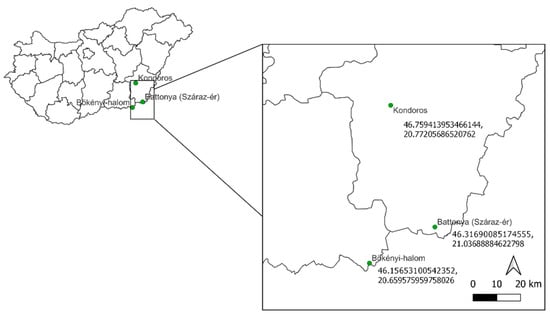
Figure 1.
Map of the sampled verges.
Overall, 41 blocks of verges were separated and surveyed in the area (Figure 2). A section extended until it was interrupted by a perpendicular dirt road or until it was ploughed away. Signs in the shape of a triangle (e.g., J4, J5) indicate that in these cases not only verges but a larger patch (old farm sites) have remained.
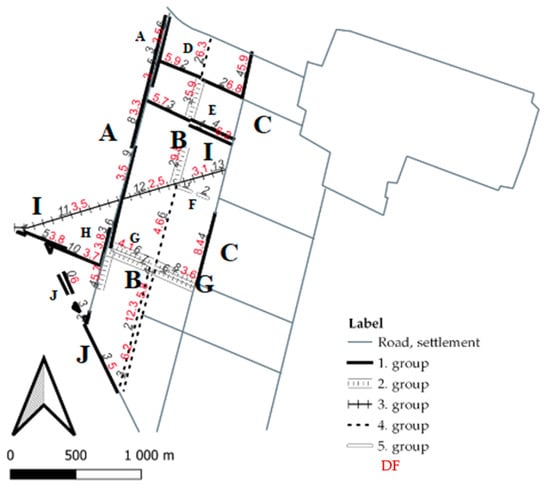
Figure 2.
Map of the sampled verges and their code. The age group of sampled verges and the number of their loess species (black numbers), DF: degree of degradation.
Military survey maps I–III were applied to determine the age of the verges [,,,].
Based on the supplemented list of species (Supplementary Materials) in the verges paths and the recorded species in the coenological surveys, the degree of degradation of each quadrat was given using the nature conservation value categories (TVK), according to Simon []:
The following formula was used:
Df is the degree of degradation. Minimum value is 2.2; maximum value is 12.3.
Nature conservation value categories (Simon 2000):
- I.
- group: natural condition indicative taxa
U—unique species, KV—specially protected species, V—protected species, E—constant species, K—accompanying species, TP—pioneers.
- II.
- group: degradation indicator taxa
TZ—natural disturbance tolerant, A—adventive species, G—economic crops, GY—weeds.
We defined loess species according to category of 5.3 of the Horváth et al. [] database because loess species belong to constant species, and within this category they are diagnostic species of loess grasslands.
Species names are given according to the nomenclature of Király [].
2.2. Diversity Studies
Floristic and coenological surveys were carried out between 15–21 May and 5–11 September in 2020 on the verges at Kondoros. The reason why these two periods were chosen was that they provided representative data on vegetation for the whole growing season.
Coenological surveys on the plots of verges were carried out in 2 × 2 m quadrats, of which were surveyed in each plot along 50 m transects, marked at every 10 m from the centre of the verges towards the two ends. Quadrats were made according to the method of Braun-Blanquet [], but coverage was given in percentage.
Classification and diversity analysis of the verges was carried out according to the floristic data collection and the species data in the coenological surveys.
During the classification, we analysed 3 verges types. I. interspaced verges, II. border verges and III. periodic verges. Interspaced verges are between two objects (e.g., road-railway, canal-dirt road). Border verges are situated next to roads, railways, canals so on and so forth. Periodic verges are grass verges that are in direct contact with agricultural fields from both sides. The border verge was divided into wide and narrow verges. Wide one was wider than 5 m, and narrow one was narrower than 5 m.
For data analysis and presenting the results, PAST (PAleontological STatictics Version 3.06) [,] statistical software was used. For comparing the vegetation of localities, multivariate hierarchic cluster analysis (UPGMA—Unweighted pair-group average) [] was conducted using Euclidean distance. From the point of view of the topic, diversity of vegetation is particularly important, therefore after contracting the data based on vegetation types, they were also analysed using Rényi diversity profiles [].
2.3. Taxonomy Investigations
Specimens from specific taxa were selected for examination where the species were known with certainty to occur. Thus, individuals from the loess grassland of Tompapuszta (Szárazér), which is the largest patch of contiguous loess grassland in parts of the east of the river Tisza, were examined for Festuca rupicola taxon and based on the preliminary hypothesis, for Festuca callierei. We studied the specimens of Festuca pseudovina from the saline grassland close to Biharugra, and we examined Fesuca valesiaca individuals from the Bökény Cumanian mounds, where Penksza [,] noticed this taxon. Hence, we distinguished 4 taxa.
In the case of each taxon, 25 floral morphological parameters of 20 plants were measured and averaged: 1. Inflorescence parameters of investigated Festuca taxa. 1. Length of the generative stem; 2. Length of inflorescence; 3. Length of the longest branch on the 1st node; 4. Length of the longest branch on the 2nd node; 5. Length of the 4th spikelet from the top of the branch (1); 6. Length of 4th spikelet from the top of inflorescence; and 7. Length of the 1st internode of the inflorescence. 8–15 (1): 4th spikelet from the top of the branch (2): 8. The floral number of spikelets, 9. Length of upper glume, 10. Length of lower glume, 11. Length of the 2nd flower’s lemma, 12. Length of the 2nd flower’s awn, 13. Hair of spikelet, 14. Length of the 1st flower’s lemma, 15. Length of the 1st flower’s awn, 16–24. 4th spikelet from the top of inflorescence: 16: Floral number of the spikelet, 17. Length of upper glume, 18. Length of lower glume, 19. Length of the 2nd flower’s lemma, 20. Length of the 2nd flower’s awn, 21. Hair of spikelet 22. Length of the 1st flower’s lemma, 23. Length of the 1st flower’s awn, and 24. Length of the 2d flower’s awn.
Localised sampling was applied following work of Penksza et al. [], measuring the length of the fourth spikelet from the top of branch and length of fourth spikelet from the top of inflorescence.
3. Results
3.1. Ages and Natural Conditions of the Verges
According to the first military survey map [,,,], the area of Kondoros was a contiguous grassland in the first half of the 19th century.
Grasslands have been classified to these groups from this period to nowadays (Figure 2). Cereals were in high demand in the middle of the 19th century, encouraging landlords to cultivate more fields. At this time, Kondoros also emerged. The first military survey map includes verges and grasslands in the first group. The second military survey map [] was done between 1874 and 1878, so the first shown and border verges roads on this map are at least 135–140 years old. These verges belong to the second group (Figure 2).
The following map, which was made in the 1930s, reveals the third group of verges (Figure 2), a strip of grass that borders the Kondoros-Kisszénás railway line. We certainly know that this strip of grass is older than that (120 years old), because the railway line was built in 1893. Fourth and fifth groups are composed by the youngest verges. We classified in the fourth group those that were already visible on the 1953–1959 map, and in the fifth group those that emerged even later (Figure 2).
Figure 3 shows the studied units of verges with the already mentioned age groups. Each unit of verges was identified by the numbers of typical loess occurring species. Species in groups E and K belong to the loess species. Based on the literature, we can expect that primary verges might be more valuable than left fallow of secondary verges from a conservation point of view. Most of the loess species did not appear in one of the old verges of the first group, but were found in the verges of railway. The three highest values were related to the three verges of railway (I1, I2, I3), which belong to the third group. Only the A3, A5 and H3 verges had higher than average amounts of loess within the first group.
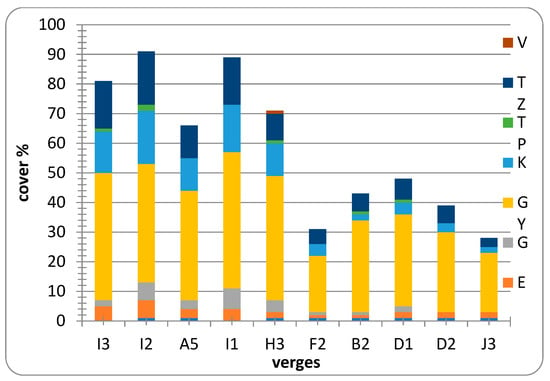
Figure 3.
Distribution of species in the ten selected verges according to the nature conservation value categories of Simon. V: protected species; TZ: disturbance tolerants; TP: natural pioneers; K: supporting taxa; GY: weeds; G: generalists; E: constant species; A: adventives.
Figure 3 shows the distribution of the five most and five least loess species of the verges according to their TVK values. It can be seen easily that the number of loess species represents the natural condition and degradation of the vegetation: the verges with more loess species indicate better natural conditions. Nevertheless, due to intensive anthropogenic effects on nature (based on examined military survey maps and current agricultural activities), it also shows that even in the most valuable verges according to these criteria, the number of weed species are significant, and even among the natural condition indicative species including unique species, specially protected species, protected species, constant species, accompanying species, pioneers; and the disturbance-tolerant species are dominant.
Looking at the degree of degradation, we get similar results. On Figure 2, we have given a number next to each quadrat representing the degree of degradation. The lower number indicated the lower degree of degradation. Using this indicator also proved that the field of railway “I” in the second category seemed to be the most natural. E2 verge is in the first group, although its degree of degradation is 12.3, which is almost the highest (Table 1).

Table 1.
Degree of degradation of sample areas.
3.2. Results of the Diversity Study of the Verges
Based on the coenological data, there were two types of verges, which were the interspaced verge and the border verge, but within these there was a wide one (Figure 4A(II)), which was wider than 5 m, and a narrow one, which was narrower than 5 m (Figure 4A(III)). These coenological data were used to generate the classification analysis. In the results, these data were well distinguished (Figure 4A). Data of 14 quadrats of interspaced verges could be characterized clearly, although data of 2 quadrats of interspaced verges can be found in this clade, but their features similar to wide border verge, clade II. Species from clade III were the most uniform.
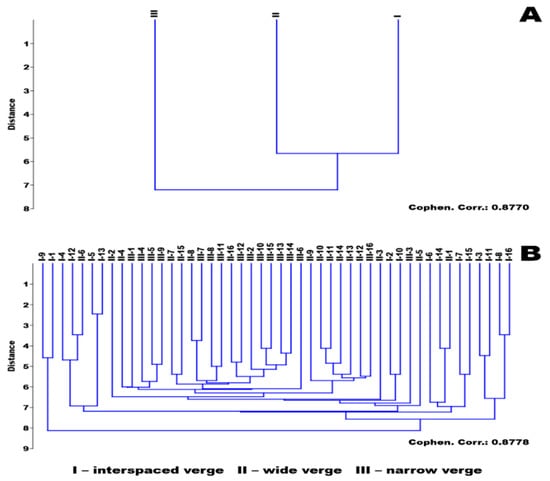
Figure 4.
Classification based on the interspaced verge (I) and the wide verge (II) and narrow verge (III) quadrats (A): based on occurrences of cumulative average, (B): based on occurrences of releves).
The number of species was highest in the type I, the interspaced verge (between 80 and 95), compared to surveys of the wide border verge (between 60 and 70) and the narrow verge (between 40 and 45).
Based on the diversity assessment from the survey, data of the interspaced verge showed the highest diversity value (Figure 5). The least diverse was the data of the type of the narrow verge with the highest number of species in this verge type.
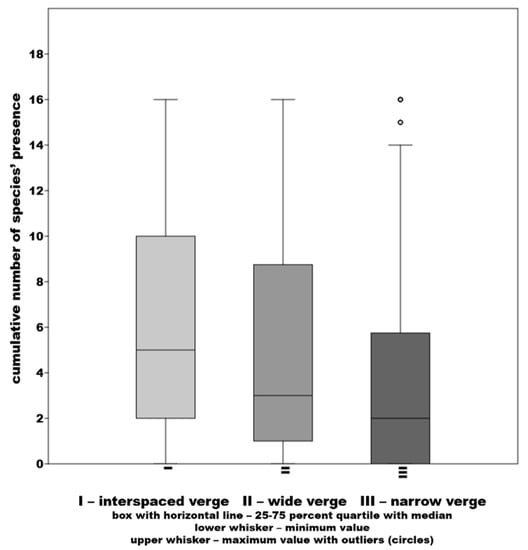
Figure 5.
Diversity based on the interspaced verge (I) and the wide verge (II) and narrow verge (III) quadrats.
Each occurring protected species in the area (seven species) can be found in the interspaced verges: Hypericum elegans, Linaria biebersteinii ssp. strictissima, Sternbergia colchiciflora, Vinca herbacea, Ornithogalum pyramidale, Salvia nutans, and Amygdalus nana. Five species are in the wide verge (II): Hypericum elegans, Linaria biebersteinii ssp. strictissima, Sternbergia colchiciflora, Ornithogalum pyramidale, and Amygdalus nana. There are four species in total in the wider (II) survey of the border verge: Hypericum elegans, Linaria biebersteinii ssp. strictissima, Sternbergia colchiciflora, and Ornithogalum pyramidale.
3.3. Results of Taxonomy Investigation
Among the studied taxa, Festuca pseudovina was separated clearly as a homogeneous group. Specimens of Festuca pseudovina show the smallest sizes among all measured inflorescence and flower parameters (Figure 6). Inflorescence parameters of Festuca rupicola show the longest values, but the sizes of Festuca rupicola 2 are closer to F. pseudodovina specimens and to individuals of the suspected Festuca callieri taxon. Within the individual parameters, the following parameters showed the most significant variation, which was typical especially for Festuca rupicola. They were much higher and inflorescences were much longer (1. parameter). There were significantly longer inflorescences (2. parameter), the longest branch of the first node (3. parameter), and the longest lateral axis on the second node (4. parameter). In addition, there were also significant differences in the size of the spikelets. The length of the awn was also significantly different (12., 15., 21., 24. parameters), which was a useful and easily applicable traits for identification.
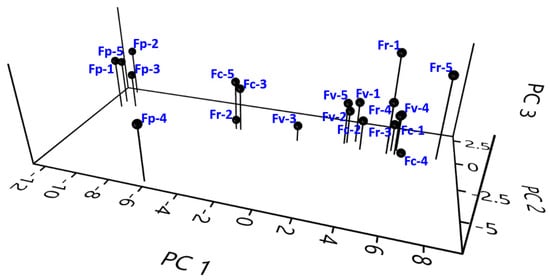
Figure 6.
3D PCA analysis of the studied Festuca specimens.
4. Discussion
Festuca rupicola is a dominant grassland species on the loess grasslands (Salvio nemorosae-Festucetum rupicolae) and it is the namesake species of the association. However, there is also a diversity of Festuca taxa on areas of verges and patches of loess grasslands in the landscape (Tompapuszta, Bökény Cumanian mound) [,]. Festuca specimens with narrower leaves than F. rupicola and with more significant differences in size (Penksza 2009) in inflorescence parameters were also found, which could belong to several species. The narrow-leaved specimens could be considered to belong mainly to the landscape-dominant F. pseudovina, but former surveys [], suggested that Festuca valesiaca also occurred in the area and that [,] it is possible that Festuca callieri, a former potentially indicated taxon, could also be found in the Pannonian flora [,]. Furthermore, taxonomic studies have been done in order to clarify these species. The question of the species occurring in the verges was expanded by a taxonomic study and a morphotaxonomic investigation of the Festuca taxa in the loess fragments of the area.
Based on the data, the current investigation of the loess grassland fragments and verges revealed that age was not the primary factor that effect on the richness and diversity of the vegetation of the fragments, the preservation or the development of the original loess vegetation. Based on the used natural condition indicators, some sections of the “I” and “A” verges represent the most natural patterns, which are not equal in age. The two groups of verges are very different according to their age. It can be confirmed through similar publications that besides age, landscape management has an important role [,,], and that the features of the component species of the vegetation are important for species composition, especially in the case of specialist species sensitive to the loss of metapopulation connections [,,,,].
Based on the current studies, two very important factors in the diversity of vegetation have been found to be the confinement and isolation of the area, which has been the best way to conserve species, similarly in the case of the Cumanian mounds, where the value is conserved by the Cumanian mounds that emerge from the landscape [,,,]. Moreover, it is important that these verges do not have any direct contact with farmland, and the structure is very important for biodiversity [,,].
A2 and A5 are sections of verges where the strip of grassland is separated from the strip of forest by a deep ditch. These living buffer strips help to reduce negative impacts from agricultural fields such as fertiliser and chemical leaching. Based on the maps, it is also important to emphasize that the “A” verge with a ditch and a tree line, which is near Kondoros, has always been considered a significant road (Figure 7). According to our observations, the occurrence of ditches has also negative effects, such as the expansion of invasive species and intensive scrub [,] (Figure 8).
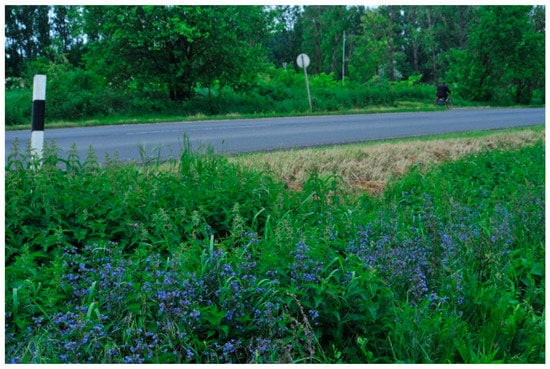
Figure 7.
Border verge with a protected Anchusa barrelieri population, Kondoros (Photo: Zsuzsanna Sutyinszki).
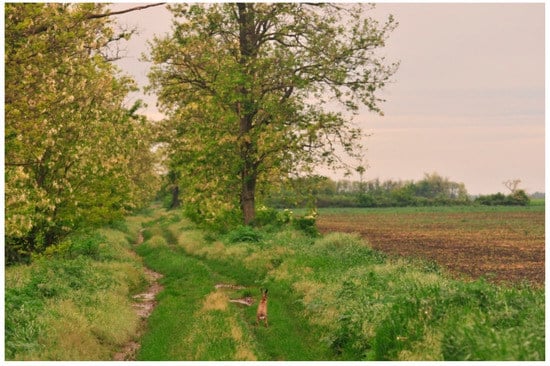
Figure 8.
Interspaced verge, Kondoros (Photo: Zsuzsanna Sutyinszki).
Another verge with good natural condition is the “I”, which is situated along the railway line. This verge is 120 years old; it must be secondary in origin. In contrast, it has the best values for numerous indicators of all the studied verges. It is one of the widest verges, it is an interspaced verge that does not contact the farmland and so is not affected by negative impacts [,]. However, it has been threatened seriously by suspension of railway traffic, as shrub growth has been intensive throughout the verges, similarly to other processes in other areas, which is harmful for grasslands [,,,,,,,].
During the investigations of the dominant Festuca species on the loess grassland, it was obvious that Fetsuca pseudovina is not found in the area. Based on the taxon parameters, it is well distinguishable from other potentially occurring species []. Results confirmed the occurrence of Festuca rupicola. Our studies have also verified that length of the palea of the second flower of the spikelet is one of the most reliable traits []. Occurrence of Festuca valesiaca and Festuca callieri cannot be concluded by inflorescence parameters only, because sclerenchyma studies are necessary for this purpose. The probability of Festuca callieri Margf. occurrence in the area cannot be refuted according to these studies. Only after the leaf histology and molecular analyses can it be concluded clearly.
5. Conclusions
Based on our research, age is not the primary factor, but isolation is. In order to sustain the areas, a buffer zone of half a meter to 1 m and conservation management (mowing, grazing, shrub cutting) are necessary. Hence, it can be concluded that not only the degree of age but also landscape use, width and position of verges is important for the composition of the vegetation. We should not rely only on the age of the verges to make hypotheses about its natural condition and vegetation.
During our work, we tried to define the Festuca species under field conditions, but morphological features do not provide a clear identification of the examined Festuca species. We tried to define these species through the morphological investigation of inflorescence in order to identify species during coenological survey, although these data were not enough for definition. Therefore, leaf cross-sectional analysis will be needed for a reliable species definition in the future.
Supplementary Materials
The following are available online at https://www.mdpi.com/article/10.3390/d14070510/s1, Table S1: Species of the coenological survey.
Author Contributions
Conceptualization, K.P. and S.S.; methodology, K.P. and S.S.; software, Z.H.S. and D.S.; investigation, S.S., Z.S., T.K., A.F. and K.P.; data curation, K.P.; writing—original draft preparation, S.S. and Z.S.; writing—review and editing, A.F. and K.P.; funding acquisition, K.P. All authors have read and agreed to the published version of the manuscript.
Funding
The work was funded by OTKA K-125423 and the Körös-Maros National Park.
Institutional Review Board Statement
Not applicable.
Informed Consent Statement
Not applicable.
Data Availability Statement
Not applicable.
Conflicts of Interest
The authors declare no conflict of interest.
References
- Török, P.; Valkó, O.; Deák, B.; Kelemen, A.; Tóth, E.; Tóthmérész, B. Managing for composition or species diversity?—Pastoral and year-round grazing systems in alkali grasslands. Agric. Ecosyst. Environ. 2016, 234, 23–30. [Google Scholar] [CrossRef] [Green Version]
- Török, P.; Penksza, K.; Tóth, E.; Kelemen, A.; Sonkoly, J.; Tóthmérész, B. Vegetation type and grazing intensity jointly shape grazing on grassland biodiversity. Ecol. Evol. 2018, 8, 10326–10335. [Google Scholar] [CrossRef] [PubMed]
- Erdős, L.; Tolgyesi, C.; Cseh, V.; Tolnay, D.; Cserhalmi, D.; Körmöczi, L.; Gellény, K.; Bátori, Z. Vegetation history, recent dynamics and future prospects of a Hungarian sandy forest-steppe reserve: Forest-grassland relations, tree species composition and size-class distribution. Community Ecol. 2015, 16, 95–105. [Google Scholar] [CrossRef] [Green Version]
- Erdős, L.; Krstonošić, D.; Kiss, P.J.; Bátori, Z.; Tölgyesi, C.; Škvorc, Ž. Plant composition and diversity at edges in a semi-natural forest–grassland mosaic. Plant Ecol. 2019, 220, 279–292. [Google Scholar] [CrossRef] [Green Version]
- Molnár, Z.; Biró, M.; Bartha, S.; Fekete, G. Past Trends, Present State and Future Prospects of Hungarian Forest-Steppes. In Eurasian Steppes. Ecological Problems and Livelihoods in a Changing World; Werger, M.J.A., Staalduinen, M.A., Eds.; Springer Science & Business Media: New York, NY, USA, 2012; Volume 6, pp. 209–252. [Google Scholar]
- Wesche, K.; Ambarlı, D.; Kamp, J.; Török, P.; Treiber, J.; Dengler, J. The Palaearctic steppe biome: A new synthesis. Biodivers. Conserv. 2016, 25, 2197–2231. [Google Scholar] [CrossRef]
- Bátori, Z.; Erdős, L.; Kelemen, A.; Deák, B.; Valkó, O.; Gallé, R.; Bragina, T.M.; Kiss, P.J.; Kröel-Dulay, G.; Tölgyesi, C. Diversity patterns in sandy forest-steppes: A comparative study from the western and central Palearctic. Biodivers. Conserv. 2018, 27, 1011–1030. [Google Scholar] [CrossRef]
- Dengler, J.; Janišová, M.; Török, P.; Wellstein, C. Biodiversity of Palaearctic grasslands: A synthesis. Agric. Ecosyst. Environ. 2014, 182, 1–14. [Google Scholar] [CrossRef] [Green Version]
- Mucina, L.; Bültmann, H.; Dierßen, K.; Theurillat, J.P.; Raus, T.; Čarni, A.; Šumberová, K.; Willner, W.; Dengler, J.; García, R.G.; et al. Vegetation of Europe: Hierarchical floristic classification system of plant, bryophyte, lichen, and algal communities. Appl. Veg. Sci. 2016, 19, 3–264. [Google Scholar] [CrossRef]
- Walter, H.; Lieth, H. Klimadiagramm-Weltatlas, 3rd ed.; Gustav Fischer: Jena, Germany, 1967. [Google Scholar]
- Willner, W.; Kuzemko, A.; Dengler, J.; Chytrý, M.; Bauer, N.; Becker, T.; Biţă-Nicolae, C.; Botta-Dukát, Z.; Čarni, A.; Csiky, J.; et al. A higher-level classification of the Pannonian and western Pontic steppe grasslands (Central and Eastern Europe). Appl. Veg. Sci. 2016, 20, 143–158. [Google Scholar] [CrossRef] [Green Version]
- Zólyomi, B.; Kéri, M.; Horváth, F. Spatial and temporal changes in the frequency of climatic year types in the Carpathian Basin. Coenoses 1997, 12, 33–41. [Google Scholar]
- Hartel, T.; Dorresteijn, I.; Klein, C.; Máthé, O.; Moga, C.I.; Öllerer, K.; Roellig, M.; von Wehrden, H.; Fischer, J. Wood-pastures in a traditional rural region of Eastern Europe: Characteristics, management and status. Biol. Conserv. 2013, 10, 267–275. [Google Scholar] [CrossRef]
- Csontos, P.; Tamás, J. Fás mezsgyék növényzetének vizsgálata a Balaton-felvidéken. Acta Agron. Ovariensis 2007, 49, 3–13. [Google Scholar]
- Szerényi, J.; Kalapos, T. Löszpusztai vegetáció maradványai az Érd-százhalombattai Sánc-hegyen. In Proceedings of the Lippay János—Vas Károly Tudományos Ülésszak, Szt. István Egyetem, Budapest, Hungary, 6–7 November 2000. [Google Scholar]
- Barczi, A.; Penksza, K.; Joó, K. Alföldi kunhalmok talaj-növény összefüggés-vizsgálata. Agrokémia Talajt. 2004, 53, 3–16. [Google Scholar] [CrossRef]
- Csathó, A.I. A mezsgyék természetvédelmi jelentősége az Alföld löszvidékein. Tájökológiai Lapok 2005, 3, 363–364. [Google Scholar]
- Csathó, A.I. Mezsgyék kutatása a Körös-Maros Nemzeti Park Igazgatóság működési területén. In Kutatási Jelentés; KMNPI: Szarvas, Hungary, 2008. [Google Scholar]
- Csathó, A.I. Előzetes javaslatok a mezsgyék mintavételezéséhez. In Magyar Ökológus Kongresszus, Előadások és poszterek összefoglalói; MÖK: Szeged, Hungary, 2009; Volume 8, p. 41. [Google Scholar]
- Csathó, A.I. Az elsődleges és másodlagos mezsgyék növényzetének összehasonlító vizsgálata a battonyai Gránic és Csárda-dűlő példáján. Tájökológiai Lapok 2011, 9, 345–356. [Google Scholar]
- Tóth, A. A kunhalom-kérdésről. In A kunhalmokról más Szemmel; Tóth, A., Ed.; Alföldkutatásért Alapítvány: Kisújszállás-Debrecen, Hungary, 2004; pp. 7–12. [Google Scholar]
- Deák, B.; Tóthmérész, B.; Valkó, O.; Sudnik-Wójcikowska, B.; Bragina, T.M.; Moysiyenko, I.; Bragina, T.M.; Apostolova, I.; Dembicz, I.; Bykov, N.I.; et al. Cultural monuments and nature conservation: The role of kurgans in maintaining steppe vegetation. Biodivers. Conserv. 2016, 25, 2473–2490. [Google Scholar] [CrossRef]
- Sudnik-Wójcikowska, B.; Moysiyenko, I.I.; Zachwatowicz, M.; Jabłońska, E. The value and need for protection of kurgan flora in the anthropogenic landscape of steppe zone in Ukraine. Plant Biosyst. 2011, 145, 638–653. [Google Scholar] [CrossRef]
- Deák, B.; Valkó, O.; Török, P.; Tóthmérész, B. Factors threatening grassland specialist plants—A multi-proxy study on the vegetation of isolated grasslands. Biol. Conserv. 2016, 204, 255–262. [Google Scholar] [CrossRef]
- Deák, B.; Bede, Á.; Rádai, Z.; Tóthmérész, B.; Török, P.; Torma, A.; Lőrinczi, G.; Nagy, A.; Mizser, S.; Kelemen, A.; et al. Different extinction debts among plants and arthropods after loss of grassland amount and connectivity. Biol. Conserv. 2021, 264, 109372. [Google Scholar] [CrossRef]
- Deák, B.; Rádai, Z.; Bátori, Z.; Kelemen, A.; Lukács, K.; Kiss, R.; Mák, E.I.; Valkó, O. Ancient burial mounds provide safe havens for grassland specialist plants in transformed landscapes—A trait-based analysis. Front. Ecol. Evol. 2021, 9, 619812. [Google Scholar] [CrossRef]
- Kiss, I. Ősgyep-maradvány az orosházi Nagytatársáncon. Acta Acad. Paedagog. Szeged. 1968, 2, 39–61. [Google Scholar]
- Didham, R.K.; Tylianakis, J.M.; Gemmell, N.J.; Rand, T.A.; Ewers, R.M. Interactive effects of habitat modification and species invasion on native species decline. Trends Ecol. Evol. 2007, 22, 489–496. [Google Scholar] [CrossRef] [PubMed]
- Pauchard, A.; García, A.; Zalba, S.; Sarasola, M.; Zenni, R.; Ziller, S.; Nuñez, M.A. Pine Invasions in South America: Reducing Their Ecological Impacts Through Active Management. In Biological Invasions in Changing Ecosystems: Vectors, Ecological Impacts, Management and Predictions; Canning Clode, J., Ed.; De Gruyter Open Ltd.: Warsaw, Poland, 2016; pp. 318–342. [Google Scholar]
- Bajor, Z.; Zimmermann, Z.; Szabó, G.; Fehér, Z.; Járdi, I.; Lisztes-Szabó, Z.; Penksza, K. Effect of conservation management practices on sand grassland vegetation in Budapest, Hungary. Appl. Ecol. Environ. Res. 2016, 14, 233–247. [Google Scholar] [CrossRef]
- Soó, R. A magyar flóra és vegetáció rendszertani-növényföldrajzi kézikönyve I. In Synopsis Systematico-Geobotanica Florae Vegetationisque Hungariae I; Akadémia Kiadó: Budapest, Hungary, 1964. [Google Scholar]
- Kiss, I. Az Adonis volgensis lelőhelyei és népies gyógyászati vonatkozásai. Magyarországon. Acta Academ. Pedagog. Szeged. 1964, 2, 25–51. [Google Scholar]
- Bagaria, G.; Helm, A.; Rod`a, F.; Pino, J. Assessing coexisting plant extinction debt and colonization credit in a grassland–forest change gradient. Oecologia 2015, 179, 823–834. [Google Scholar] [CrossRef] [Green Version]
- Biro, M.; Bölöni, J.; Molnár, Z. Use of long-term data to evaluate loss and endangerment status of Natura 2000 habitats and effects of protected areas. Conserv. Biol. 2018, 3, 660–671. [Google Scholar] [CrossRef] [Green Version]
- Deák, B.; Tölgyesi, C.; Kelemen, A.; Bátori, Z.; Gallé, R.; Bragina, T.M.; Abil, Y.A.; Valkó, O. The effects of micro-habitats and grazing intensity on the vegetation of burial mounds in the kazakh steppes. Plant Ecol. Divers. 2017, 10, 509–520. [Google Scholar] [CrossRef]
- Kuussaari, M.; Bommarco, R.; Risto, K.; Heikkinen, R.; Helm, A.; Krauss, J.; Lindborg, R.; Öckinger, E.; Pärtel, M.; Pino, J.; et al. Extinction debt: A challenge for biodiversity conservation. Trends Ecol. Evol. 2009, 24, 564–571. [Google Scholar] [CrossRef]
- Joanne Clavel, J.; Julliard, R.; Devictor, V. Worldwide decline of specialist species: Toward a global functional homogenization? Front. Ecol. Environ. 2004, 9, 222–228. [Google Scholar] [CrossRef] [Green Version]
- Saunders, D.A.; Hobbs, R.J.; Margules, C.R. Biological consequences of ecosystem fragmentation: A review. Conserv. Biol. 1991, 5, 18–32. [Google Scholar] [CrossRef]
- Archer, S.; Bouton, T.W.; Hibbard, K.A. Trees in Grasslands: Biogeochemical Consequences of Woody Plant Expansion. In Global Biogeochemical Cycles and Their Interrelationship with Climate; Schulze, E.A., Harrison, S.P., Heimann, M., Holland, E.A., Lloyd, J., Prentice, I.C., Schimel, D.S., Eds.; Academic Press: London, UK, 2001; pp. 115–130. [Google Scholar]
- Yezzi, A.; Nebbia, A.; Zalba, S. Fragmentation of Coastal Grasslands by Plantations and Spontaneous Spread of Invasive Pines in the Southern Pampa. Diversity 2021, 13, 637. [Google Scholar] [CrossRef]
- Penksza, K.; Loksa, G.; Barczi, A.; Joó, K.; Malatinszky, Á. Effects of extrazonal and climatic conditions on the vegetation of kurgans. A pilot study from the Hortobágy (Csípő-halom). In Kurgan studies: An Environmental and Archaeological Multiproxy Study of Burial Mounds in the Eurasian Steppe Zone; Pető, Á., Barczi, A., Eds.; BAR International Series: Oxford, UK, 2011; pp. 347–350. [Google Scholar]
- Deák, B.; Valkó, O.; Török, P.; Kelemen, A.; Miglécz, T.; Szabó, S.; Szabó, G.; Tóthmérész, B. Micro-topographic heterogeneity increases plant diversity in old stages of restored grasslands. Basic Appl. Ecol. 2015, 16, 291–299. [Google Scholar] [CrossRef]
- Rákóczi, A.; Barczi, A. Protected landscape elements in the European Union, the influence of EC decree 73/2009 on the condition of Hungarian mounds. Tájökológiai Lapok 2014, 12, 95–105. [Google Scholar]
- Tóth, C.A.; Deák, B.; Nyilas, I.; Bertalan, L.; Valkó, O.; Novák, T. Iron age burial mounds as refugia for steppe specialist plants and invertebrates—Case study from the Zsolca mounds (NE Hungary). Hacquetia 2019, 18, 195–206. [Google Scholar] [CrossRef] [Green Version]
- Vona, M.; Penksza, K. A szentesi Kántor-halom vegetációjának változása és ennek összefüggése a talaj vízháztartásával. Tájökológiai Lapok 2004, 2, 341–348. [Google Scholar]
- Kiss, T.; Penksza, K. A legeltetés hosszú távú hatása kiskunsági füves pusztákon. Természetvédelmi Közlemények 2018, 24, 104–113. [Google Scholar] [CrossRef]
- Kiss, T.; Penksza, K.; Tasi, J.; Szentes, S. Juh-és marhalegelő cönológia és gyepgazdálkodási vizsgálata kiskunsági területeken. Gyepgazdálkodási Közlemények 2008, 6, 39–45. [Google Scholar]
- Kiss, T.; Lévai, P.; Ferencz, Á.; Szentes, S.; Hufnagel, L.; Nagy, A.; Balogh, Á.; Pintér, O.; Saláta, D.; Házi, J.; et al. Change of composition and diversity of species and grassland management between different grazing intensity—In Pannonian dry and wet grasslands. Appl. Ecol. Environ. Res. 2011, 9, 197–230. [Google Scholar] [CrossRef]
- Herczeg, E. Botanikai vizsgálatok kunhalmok Dél-tiszántúli löszgyepein. Kanitzia 2005, 13, 45–54. [Google Scholar]
- Herczeg, E.; Pottyondy, Á.; Penksza, K. Cönológiai vizsgálatok eltérő gazdálkodású dél–tiszántúli löszgyepekben. Tájökológiai Lapok 2005, 3, 259–265. [Google Scholar]
- Nagy, A.; Penksza, K. Élőhely–értékelési lehetőségek dél–tiszántúli és veresegyházi területeken természetességi mutatók alapján. Tájökológiai Lapok 2006, 4, 115–125. [Google Scholar]
- Nagy, A.; Penksza, K. A Vésztő–Mágor Természetvédelmi Terület élőhelytérképe, és környezetgazdálkodási–természetvédelmi értékelési lehetősége. Tájökológiai Lapok 2007, 5, 103–116. [Google Scholar]
- Nagy, A.; Penksza, K.; Laborczi, A.; Kiss, T. Habitat mapping of Vésztő–Mágorpuszta (South–East Hungary) protected natural area. Lucr. Ştitinţifice 2007, 9, 125–132. [Google Scholar]
- Penksza, K. Die Koerrektur der histologischen Beschreibung von Festuca javorkae von Májovszky im Jahre 1962, und Angaben zum Vorkommnis der Art in Ungarn. Ber. Inst. Landsch. Pflanz. Univ. Hohenh. 2000, 10, 49–54. [Google Scholar]
- Penksza, K. Poaceae—Pázsitfüvek nemzetségeinek határozókulcsa. Festuca—Csenkeszek, Lolium—Vadóc, Festulolium—Korcsvadóc. In Új Magyar Fűvészkönyv; Király, G., Ed.; Aggteleki Nemzeti Park: Aggtelek, Hungary, 2009; pp. 498–509. [Google Scholar]
- Penksza, K.; Csík, A.; Filep, A.F.; Saláta, D.; Pápay, G.; Kovács, L.; Varga, K.; Pauk, J.; Lantos, C.; Lisztes-Szabó, Z. Possibilities of Speciation in the Central Sandy Steppe, Woody Steppe Area of the Carpathian Basin through the Example of Festuca Taxa. Forests 2020, 11, 1325. [Google Scholar] [CrossRef]
- Penksza, K.; Saláta, D.; Pápay, G.; Péter, N.; Bajor, Z.; Lisztes-Szabó, Z.; Fűrész, A.; Fuchs, M.; Michéli, E. Do Sandy Grasslands along the Danube in the Carpathian Basin Preserve the Memory of Forest-Steppes? Forests 2021, 12, 114. [Google Scholar] [CrossRef]
- Galli, Z.; Penksza, K.; Kiss, E.; Sági, L.; Heszky, L.E. Low variability of Internal Transcribed Spacer rDNA and trnL (UAA) intron sequences of several taxa in the Festuca ovina aggregate (Poaceae). Acta Biol. Hung. 2006, 57, 57–69. [Google Scholar] [CrossRef]
- Bauer, L.; Galli, Z.; Penksza, K.; Engloner, A.; Szerdahelyi, T.; Kiss, E.; Heszky, L. Morfológiai és molekuláris taxonómiai vizsgálatok kárpát–medencei Festuca fajokon. In Kárpát–Medencei Biológiai Szimpózium; MBT: Budapest, Hungary, 2003; Volume III, pp. 33–37. [Google Scholar]
- Markgraf-Dannenberg, I. Festuca L. In Flora Europaea; Tutin, T.G., Heywood, V.H., Burges, N.A., Moore, D.M., Valentine, D.H., Walters, S.M., Webb, D.A., Eds.; Cambridge University Press: Cambridge, UK, 1980; Volume 5, pp. 125–153. [Google Scholar]
- Barczi, A.; Penksza, K.; Joó, K. Reseach of soil–plant connections on Kurgans in Hungary. Ekológia 2004, 23, 15–22. [Google Scholar]
- Dövényi, Z. Magyarország Kistájainak Katasztere; Magyar Tudományos Akadémia, Földrajztudományi Kutatóintézet: Budapest, Hungary, 2010; pp. 34–56. [Google Scholar]
- Available online: https://maps.arcanum.com/hu/map/firstsurvey-lower-austria/?bbox=1859421.4186977376%2C6117715.954432676%2C1962534.9698544405%2C6155399.409377268&map-list=1&layers=151 (accessed on 2 May 2022).
- Térképek. Magyar Királyság (1819–1869)—Második Katonai Felmérés. Available online: https://maps.arcanum.com/hu/map/secondsurvey-hungary/?layers=5&bbox=2108467.652103985%2C6019361.428761189%2C2134246.039893161%2C6027960.594443272 (accessed on 2 May 2022).
- Térképek. Habsburg Birodalom (1869–1887)—Harmadik Katonai Felmérés (1:75000). Available online: https://maps.arcanum.com/hu/map/thirdsurvey75000/?layers=43&bbox=1900697.477281965%2C6130610.723300188%2C1913586.671176553%2C6134910.306141228 (accessed on 2 May 2022).
- Arcanum. IV. A Negyedik Katonai Felmérés (1896–1914). Available online: https://www.arcanum.com/hu/online-kiadvanyok/Janko-janko-annamaria-magyarorszag-katonai-felmeresei-1/iv-a-negyedik-katonai-felmeres-1896-1914-27A/ (accessed on 2 May 2022).
- Simon, T. A Magyarországi Edényes Flóra Határozója; Tankönyvkiadó: Budapest, Hungary, 2000; pp. 34–56. [Google Scholar]
- Horváth, F.; Dobolyi, Z.K.; Morschhauser, T.; Lőkös, L.; Karas, L.; Szerdahelyi, T. FLÓRA adatbázis 1.2—Taxonlista és attribútum-állomány. In FLÓRA Munkacsoport; MTA-ÖBKI; MTM Növénytára: Vácrátót, Hungary, 1995. [Google Scholar]
- Braun-Blanquet, J. Pflanzensoziologie; Wien: New York, NY, USA, 1964; pp. 2–865. [Google Scholar]
- Király, G. Új Magyar Füvészkönyv. Magyarország Hajtásos Növényei. Határozókulcsok; Aggteleki Nemzeti Park Igazgatóság: Jósvafő, Hungary, 2009; pp. 3–456. [Google Scholar]
- Hammer, Ø. PAST—PAleontological STatictics Version 3.06 Reference Manual; Natural History Museum: Oslo, Norway; University of Oslo: Oslo, Norway, 1999–2015; pp. 3–225. [Google Scholar]
- Hammer, Ø.; Harper, D.A.T.; Ryan, P.D. PAST—Paleontological Statistics Software Package for Education and Data Analysis. Palaeontol. Electron. 2009, 4, 1–9. [Google Scholar]
- Saitou, N.; Nei, M. The neighbor-joining method: A new method for reconstructing phylogenetic trees. Mol. Biol. Evol. 1987, 4, 406–425. [Google Scholar]
- Tóthmérész, B. Comparison of different methods for diversity ordering. J. Veg. Sci. 1995, 6, 283–290. [Google Scholar] [CrossRef]
- Penksza, K.; Szabó, G.; Zimmermann, Z.; Lisztes-Szabó, Z.; Pápay, G.; Járdi, I.; Fűrész, A.; Falusi, E.S. The taxonomic problems of the Festuca vaginata agg. and their coenosystematic aspects. A Festuca vaginata alakkör taxonómiai problematikája és ennek cönoszisztematikai vonatkozásai. Georg. Agric. 2019, 23, 63–76. [Google Scholar]
- Deák, B.; Valkó, O.; Nagy, D.D.; Török, P.; Torma, A.; Lőrinczi, G.; Kelemen, A.; Nagy, A.; Bede, A.; Mizser, S.; et al. Habitat islands outside nature reserves—Threatened biodiversity hotspots of grassland specialist plant and arthropod species. Biol. Conserv. 2020, 241, 108254. [Google Scholar] [CrossRef]
- Dembicz, I.; Szczeparska, L.; Moysiyenko, I.I.; Wódkiewicz, M. High genetic diversity in fragmented Iris pumila L. populations in Ukrainian steppe enclaves. Basic Appl. Ecol. 2018, 28, 37–47. [Google Scholar] [CrossRef]
- Dembicz, I.; Moysiyenko, I.I.; Kozub, L.; Dengler, J.; Zakharova, M.; Sudnik-Wójcikowska, B. Steppe islands in a sea of fields: Where island biogeography meets the reality of a severely transformed landscape. J. Veg. Sci. 2020, 21, e12930. [Google Scholar] [CrossRef]
- Helm, A.; Hanski, I.; Pärtel, M. Slow response of plant species richness to habitat loss and fragmentation. Ecol. Lett. 2006, 9, 72–77. [Google Scholar] [CrossRef]
- Brady, M.; Kellermann, K.; Sahrbacher, C.; Jelinek, L. Impacts of decoupled agricultural support on farm structure, biodiversity and landscape mosaic: Some EU results. J. Agric. Econ. 2009, 60, 563–585. [Google Scholar] [CrossRef]
- Valkó, O.; Tóth, K.; Kelemen, A.; Miglécz, T.; Sonkoly, J.; Tóthmérész, B.; Török, P.; Deák, B. Cultural heritage and biodiversity conservation—Plant introduction and practical restoration on ancient burial mounds. Nat. Conserv. 2018, 24, 65–80. [Google Scholar] [CrossRef]
- Tölgyesi, C.; Török, P.; Hábenczyus, A.A.; Bátori, Z.; Valkó, O.; Deák, B.; Tóthmérész, B.; Erdős, L.; Kelemen, A. Underground deserts below fertility islands?—Woody species desiccate lower soil layers in sandy drylands. Ecography 2020, 43, 848–859. [Google Scholar] [CrossRef]
- Haddad, N.M.; Brudvig, L.A.; Clobert, J.; Davies, K.F.; Gonzalez, A.; Holt, R.D.; Lovejoy, T.E.; Sexton, J.O.; Austin, M.P.; Collins, C.D. Habitat fragmentation and its lasting impact on Earth’s ecosystems. Sci. Adv. 2015, 1, e1500052. [Google Scholar] [CrossRef] [Green Version]
- Wilson, M.C.; Chen, X.; Corlett, R.T.; Didham, R.K.; Ding, P.; Holt, R.D.; Holyoak, M.; Hu, G.; Hughes, A.C.; Jiang, L. Habitat fragmentation and biodiversity conservation: Key findings and future challenges. Landsc. Ecol. 2016, 31, 219–227. [Google Scholar] [CrossRef] [Green Version]
- Šmarda, P.; Šmerda, J.; Knoll, A.; Bureš, P.; Danihelka, J. Revision of Central European taxa of Festuca ser. Psammophilae Pawlus: Morphometrical, karyological and AFLP analysis. Plant Syst. Evol. 2007, 266, 197–232. [Google Scholar] [CrossRef]
Publisher’s Note: MDPI stays neutral with regard to jurisdictional claims in published maps and institutional affiliations. |
© 2022 by the authors. Licensee MDPI, Basel, Switzerland. This article is an open access article distributed under the terms and conditions of the Creative Commons Attribution (CC BY) license (https://creativecommons.org/licenses/by/4.0/).